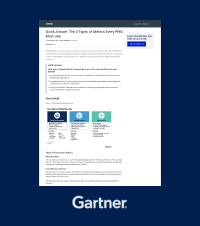10 best Capacity Planning software & tools in 2025: the ultimate guide
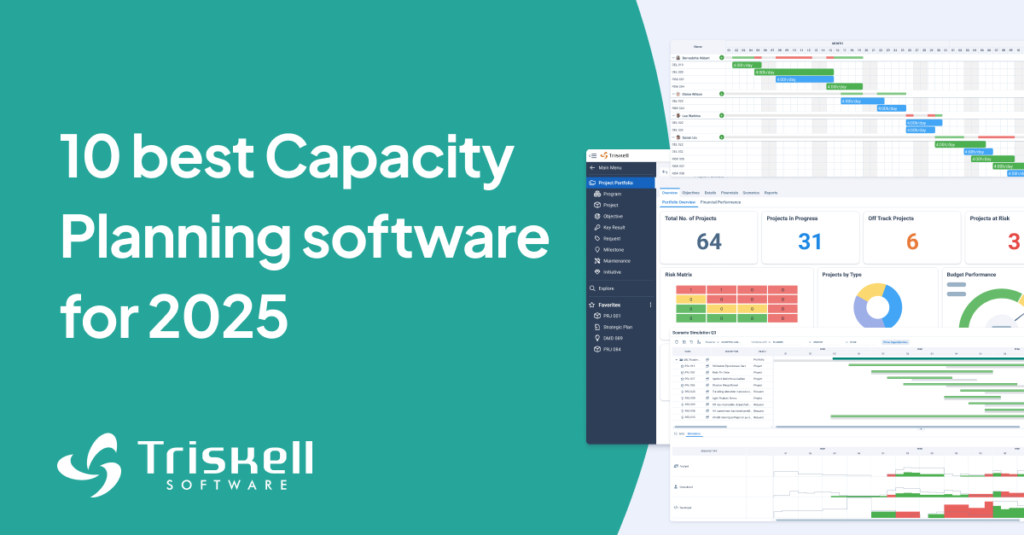
Today, efficient capacity planning and resource management is essential for any organization to succeed. As companies have to manage a greater volume of resources and projects (which, in turn, are increasingly complex), the use of capacity planning techniques and tools is mandatory.
There are many solutions available to help companies achieve their strategic objectives without overloading their teams. But how do you choose the one that best suits your needs? In this guide, we show you the best capacity planning software and tools, exploring the pros and cons of each to help you choose the best option for your organization.
What is capacity planning software?
Capacity planning software helps companies have the human resources needed to meet all incoming demand and prioritize the most strategically valuable projects. It helps you forecast workloads, identify resource and skills gaps, and evenly distribute resources across your organization’s projects.
In other words, they let you know whether your organization can handle new projects, or whether those already underway are taking up all the necessary resources. With them, you can better allocate tasks, plan for the medium and long term, and identify bottlenecks before they escalate.

RESOURCE MANAGEMENT
Streamline Capacity Planning with Triskell’s PPM solutions
See how Triskell’s Resource Management tools can help you to maximize your capacity planning processes.
Benefits of capacity planning tools
These solutions have a lot of advantages when it comes to helping you manage your organization’s resources and projects. Here are some of the reasons why you should use capacity planning software if you are not already doing so:
- Efficient resource utilization: with capacity planning software you get real-time visibility into their availability, which helps prevent them from being overused or, conversely, idle. You will be able to better distribute the workload according to your organization’s capacity, thus improving performance and reducing waiting times.
- More accurate forecasting: thanks to these tools, you can predict months in advance the requirements of future projects and anticipate if extra reinforcements and skills are needed in the organization, thus avoiding staffing problems.
- Better decision making: these solutions rely on data analytics and Business Intelligence to generate information. This allows Resource Managers, PMOs, executives and IT managers to make better decisions about resource allocation, project timelines and team workloads.
- Reduced risk of team burnout: resource constraints and overloaded teams can result in burnout, lower productivity and, worst of all, a higher turnover rate. Therefore, another benefit of capacity planning software is that managers will be able to clearly visualize how much work each resource can handle, thus distributing the workload evenly and reducing stress.
- Improved collaboration and communication: Many of these solutions include functionality for teams to collaborate. So, while managers can communicate tasks, deadlines and objectives through these tools, team members can update their progress in real time, promoting transparency and accountability.
- Cost savings: since you can plan your organization’s capacity in the long term with these tools, they will also help you avoid unnecessary spending on hiring staff that is not needed.
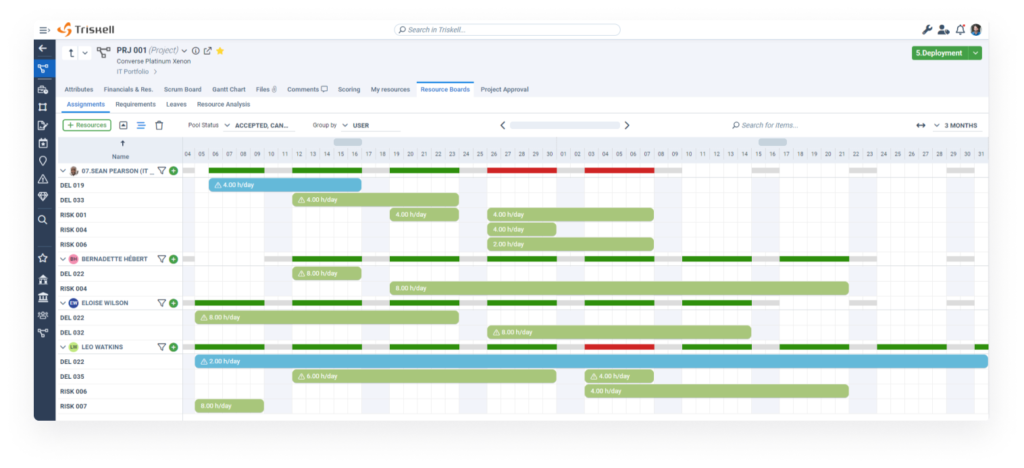
Key aspects to consider when purchasing a Capacity Planning software
Now that you know the benefits of capacity planning software, you may have come to the conclusion that having a capacity planning tool is something that can definitely make a difference in your organization.
However, there are many factors to analyze and consider when deciding on the right software for your organization. Here are some of them:
- Ease of use: you do not need to have a technical background to use this type of tool. Therefore, you must make sure that its interface is simple and easy to navigate so that all roles in your organization can use it.
- Integrations: your software must be able to integrate with the tools you already use in your company, such as Jira, Teams, Microsoft Project or SAP. This way, you avoid information silos and ensure an efficient data flow between applications.
- Flexibility: Each company has its own management and governance processes. And these must be able to be replicated in the software. Look for a solution where you can customize reports, dashboards and workflows to suit your management style.
- Scalability: Your business will grow over time. And with it, the number of projects and resources to manage will increase. You must ensure that the software can evolve at the same pace as the company does.
- Reports and dashboards: make sure that the software offers extensive possibilities to customize reports and dashboards for the different roles and stakeholders in your organization.
- Cloud vs On Premise: you should define whether you also prefer a cloud or on-premises solution. We recommend the cloud software option as it involves lower maintenance costs on your side and total freedom to access the tool from anywhere.
- Technical support: make sure that the software provider offers a support schedule, and SLAs (Service Level agreements) aligned with the needs of your organization.
- Security: software security policies and procedures also play a key role. Look for tools with encryption and role-based access, and that comply with current data protection regulations.
If you want more information about the more than 100 criteria to be taken into account when acquiring a PPM software that includes functionalities for Capacity Planning and Resource Management, we invite you to download the following checklist.
PPM SOFTWARE CHECKLIST
A Comprehensive buyer’s checklist for PPM Software
Use this quick checklist to compare potential modern PPM solutions in order to pick the best one for your organization.
Best capacity planning software & tools for 2025
Now that we’ve covered the key aspects you have to consider, let’s dive into the top 10 best capacity planning tools for 2025. These solutions stand out for their features, flexibility, and ability to help organizations effectively manage their product portfolios.
Capacity planning software #1: Triskell
Triskell Software is one of the best PPM tools on the market that organizations can use to manage their project and product portfolios, resources and overall strategy. With Triskell, you can integrate your capacity planning processes into your PPM framework, and thus ensure that resource allocation is aligned with the business strategy.
Capacity planning aligned with strategy
One of the most attractive aspects of Triskell is that it is a PPM platform that goes far beyond project and resource management, as you can link capacity planning directly to the company’s strategic objectives.
Imagine you are managing several project portfolios or you are in the middle of a business transformation process. With Triskell, you can prioritize each project based on its strategic value, and automatically adjust available resources so that the most critical initiatives have the resources they need. No strategic project will be left without resources, as staff allocation will always be aligned with business objectives.
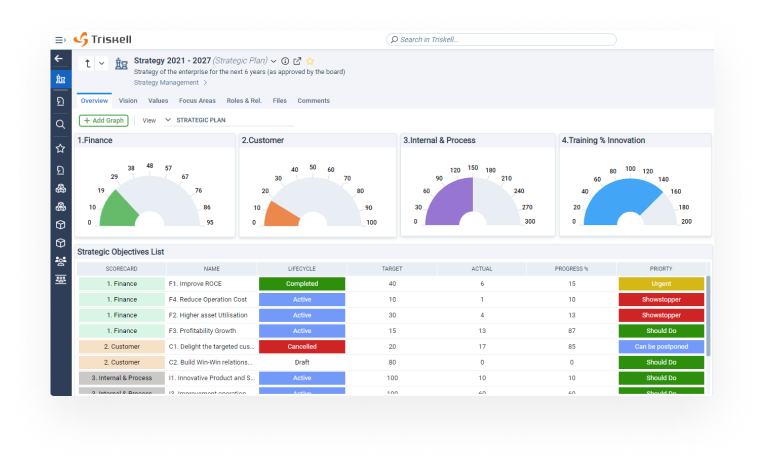
Resource Management for Agile and non-Agile projects
Another strength of Triskell is that it is a tool designed to adapt to any project management methodology. Whether Agile, Phase Gate, Lean, DevOps, SAFe or hybrid management approaches. No matter what methodology it is, they will all work in Triskell.
Within the Triskell platform you will find features and tools for both Agile teams and those who prefer to work with a more structured approach. You can switch from one management methodology to another at any time, which makes resource allocation with Triskell always seamless.
Advanced Scenario Planning tools
Other key feature of Triskell is Scenario Planning and Simulation, which will help you to improve your decision making.
Imagine you are faced with an unexpected change in strategic objectives or new projects suddenly appear. With Triskell, you can simulate what would happen if you change project priorities, or how changes in resource allocation would affect the overall performance of your project portfolios.
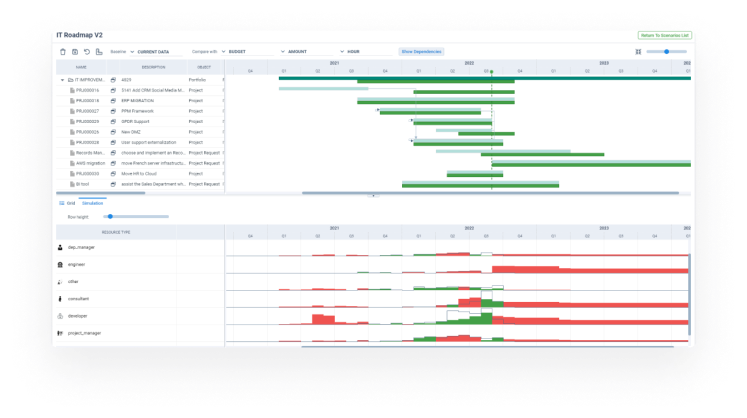
Integrations
Triskell can integrate through its API with a wide range of enterprise applications. This includes:
- ERP systems.
- SAP.
- CRM tools.
- Oracle.
- Power BI.
- Azure DevOps
- Microsoft suite products.
- Other Project Management tools (Jira, Microsoft Project).
- Etc.
Other key features of Triskell
- Timesheets: another of Triskell’s key features are its Timesheets, with which you can track in real time how resources are being used and adjust plans accordingly.
- Collaboration tools: it offers a wide range of tools to improve the collaboration and communication of your teams. Kanban and Scrum boards, task management, document sharing, alerts, notifications, comments… All this in a single interface.
- Reports and dashboards: with Triskell, you can customize reports and dashboards according to the needs of each stakeholder. Whether it’s for executives who require a strategic view of project portfolios, or Project Managers who require more task-level detail, you have infinite customization options at your fingertips.
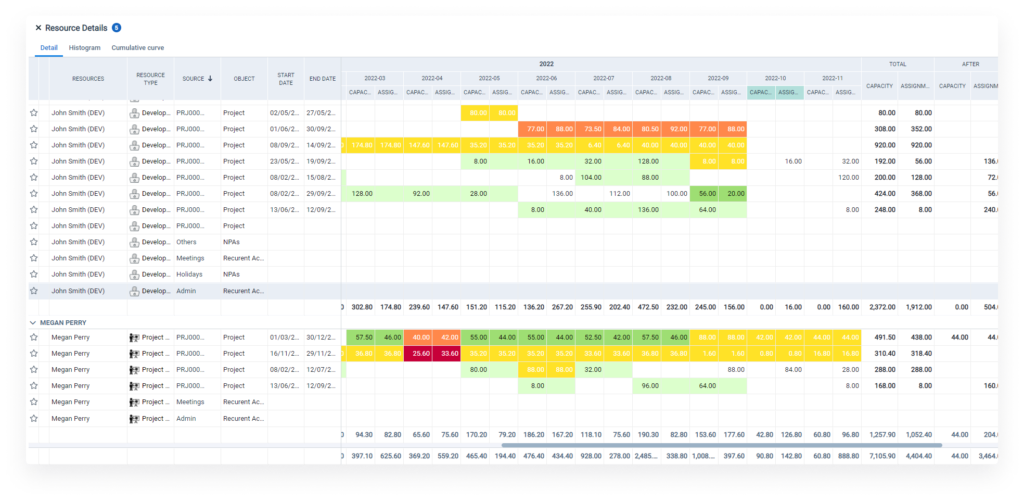
Triskell areas of improvement
- No mobile app: while the platform is accessible via web browsers on tablets and mobile devices, having a native mobile app could increase its accessibility and ease of use
- Tool administration: it requires strong technical expertise, particularly when configuring advanced reporting features or integrating SQL queries into the system.
- Learning curve: even though the software becomes highly effective once learned, the initial setup and usage can be daunting.
Triskell pricing
Customized pricing.
Triskell reviews
- Capterra: 4.7/5
- G2: 4.4/5

See Triskell’s capacity planning tools in action
See how Triskell Software can help you optimize resources, streamline processes, and improve decision-making. Request your free demo today!
Capacity planning software #2: Resource Guru
Resource Guru is a capacity planning software designed to help teams and organizations manage and plan their resources effectively. Primarily used for resource allocation, it features a very intuitive interface that makes it easy to visualize resource availability.
Resource Guru advantages
- Clear and intuitive planning: Resource Guru’s interface, with its characteristic color bar, helps you quickly see what resources are available and when.
- Customizable working hours: You can set custom working hours for each resource, which is super useful if you’ve got people working different shifts or part-time.
- Leave management: Manage vacations, sick leave, and other absences right within the Resource Guru platform.
- Simple configuration and use: This tool requires very little setup and is super easy to learn.
Resource Guru areas of improvement
- Limited project management capabilities: this isn’t the best solution if your main focus is project management. A lot of users end up integrating it with other project management tools because of these limitations.
- Integrations: the integration with Google Calendar could be improved, especially in terms of bidirectional synchronization and better visibility of availability.
- Limited reporting options: reporting options fall somewhat short when dealing with large teams.
- Pricing policy: users who need read-only permissions must have a full subscription.
Resource Guru pricing
- Grashopper Plan: $4.16 per user/month.
- Blackbelt Plan: $6.65 per user/month.
- Master Plan: $10 per user/month.
Resource Guru reviews
- Capterra: 4.7/5.
- G2: 4.7/5.
SUBSCRIBE TO OUR NEWSLETTER
Get stories like this in your inbox
Capacity planning software #3: Planview
Planview ProjectPlace is a comprehensive project management and capacity planning solution that helps organizations manage their resources, plan work and track progress in real time.
Planview ProjectPlace advantages
- All-in-one solution: in Planview, you’ll find a wide range of functionalities like Kanban boards, document management, and task tracking. Everything you need in one place!
- Workflow automation: You can automate workflows and boost your teams’ productivity.
- Resource planning: It includes advanced Resource Management functionalities, so you can allocate resources and plan capacity efficiently.
- Document and file sharing: Its file sharing and document management functionalities provide an optimal experience.
Planview ProjectPlace areas of improvement
- Time tracking functionalities: the time tracking system could be improved, especially for weekly recurring tasks, which have to be entered manually each time.
- Tool customization: customizing some features, such as document and file organization, can be complex.
- Calendar integration: Planview doesn’t have an integrated calendar, forcing you to use other tools to manage deadlines and schedules. Just one more thing to juggle!
- Interface problems: It’s not very intuitive, and it takes a while to get familiar with all the platform’s capabilities.
Planview ProjectPlace pricing
Customized pricing.
Planview ProjectPlace reviews
- Capterra: 4.7/5.
- G2: 4.1/5.
EBOOK
PPM Software Buyers’ Guide
What should you look for in a new PPM tool?
Capacity planning software #4: Meisterplan
Meisterplan is a PPM solution designed to help organizations manage their resources effectively. Thanks to its intuitive drag-and-drop interface, you can align projects with business objectives, allocate resources efficiently, and improve overall project visibility.
Meisterplan advantages
- Scenario planning: you can simulate different scenarios to make informed decisions about resource allocation and project timelines.
- Intuitive capacity planning: visualize and manage resources in real-time. Need to adjust deadlines or workloads? Just drag and drop—easy peasy!
- Role-based resource allocation: you can plan and allocate resources based on each person’s role in your organization
- Visual reporting: the reports are not only highly detailed but also easy to understand.
Meisterplan areas of improvement
- Limited resource visibility: seeing the projects assigned to each user can be a bit of a hassle. It’s not exactly user-friendly in that department.
- Operational project management features: It could use more detailed task management features to complement its resource planning capabilities.
- Limited customization: you can’t set milestones beyond certain dates or add custom filters in Meisterplan.
- Price: this solution might be a bit on the pricey side for smaller organizations or those with more modest management needs.
Meisterplan pricing
- Basic: 600 € per month (up to 50 resources)
- Pro: 800 € per month (up to 50 resources)
- Premium: 2550 € per month (up to 150 resources)
Meisterplan reviews
- Capterra: 4.7/5.
- G2: 4.8/5.

See Triskell’s capacity planning tools in action
See how Triskell Software can help you optimize resources, streamline processes, and improve decision-making. Request your free demo today!
Capacity planning software #5: Saviom
Saviom is a PPM tool with capacity planning capabilities, designed to help companies optimize resource allocation across multiple projects and ensure their teams perform at their best.
Saviom advantages
- Resource planning and allocation: Saviom’s Gantt charts give you a clear and visual representation of resource availability and project allocation.
- Highly configurable interface: It’s super flexible; you can customize screens, inputs, and workflows to fit your needs like a glove.
- Scalability: whether you’re a small team or a large organization managing hundreds of resources and projects, Saviom adapts to you. It grows as you grow!
- Filtering options: its powerful filtering tools let you view resources, projects and bookings in detail.
Saviom areas of improvement
- Resource request process: the process for requesting resources can be a bit clunky, which might add unnecessary headaches for many users when planning.
- Performance issues: the platform can get sluggish when working with large datasets. Patience is a virtue here!
- Limited export options: the export functionality to Excel and PowerPoint could be better—more flexibility and formatting options would go a long way.
- Lack of documentation: more extensive documentation is needed, especially during the tool implementation process.
Saviom pricing
Customized pricing.
Saviom reviews
- Capterra: 4.3/5.
- G2: 4.5/5.
EBOOK
PPM Software Buyers’ Guide
What should you look for in a new PPM tool?
Capacity planning software #6: Smartsheet
Smartsheet is a versatile project management and collaboration tool that brings together the familiar feel of spreadsheets with some seriously powerful resource management and capacity planning features. It lets companies manage projects, allocate resources, and streamline workflows in real-time.
Smartsheet advantages
- Resource Management: keep tabs on team availability, track workloads, and make sure resources are allocated efficiently across projects.
- User-friendly interface: Smartsheet is like a warm hug for users of all technical skill levels, thanks to its spreadsheet-like format. If you can use Excel, you can use this!
- Automated workflows: you can automate those pesky repetitive tasks like approvals and reminders without needing to write a single line of code.
- Templates and forms: It comes loaded with a wide range of templates and customizable forms to support all kinds of projects.
Smartsheet areas of improvement
- Missing key settings: some resource management settings are either missing or just a pain to use. For example, dealing with double bookings or detailed resource allocation can be a bit of a headache.
- Software performance: loading times can be pretty slow when you’re working with a lot of data or complex projects. Patience is definitely required here.
- Learning curve: while it’s mostly user-friendly, some advanced functionalities, like automation or setting up workflows, can feel like a mountain to climb for new users.
Smartsheet pricing
- Pro: 8€ per user / month.
- Business: 17€ per user / month.
- Enterprise: custom pricing.
- Advanced Work Management: custom pricing.
Smartsheet reviews
- Capterra: 4.5/5.
- G2: 4.4/5.

See Triskell’s capacity planning tools in action
See how Triskell Software can help you optimize resources, streamline processes, and improve decision-making. Request your free demo today!
Capacity planning software #7: Epicflow
Epicflow is a resource management and capacity planning tool designed to help organizations manage multiple projects in dynamic and complex environments. It’s especially great for teams managing several projects at once, offering a data-driven approach to prioritizing tasks, balancing workloads, and optimizing performance.
Epicflow advantages
- Dynamic capacity planning: with Epicflow, you can analyze resource workloads in real time and adjust them accordingly.
- Multi-project management: the platform is built for managing multiple projects simultaneously, giving you a comprehensive view of all tasks and resources.
- Scenario planning: assess the impact of changes in project scope, timelines, or resource allocation with ease.
- AI-based forecasting: Epicflow leverages AI to predict potential risks and suggests ways to optimize resource allocation.
Epicflow areas of improvement
- Data entry: Epicflow requires detailed task data, including dependencies, estimates and timelines, to really shine. Entering all that can feel like a chore.
- Bubble charts: these can be a bit confusing. It’s hard to get a clear visual of project status and health when they’re all jumbled up.
- Task dependencies: To get the most out of Epicflow, you have to set up task dependencies meticulously, with little room for error. This can be a time-sink.
- Dashboards: the customization options for dashboards are somewhat limited compared to other tools.
Epicflow pricing
Customized pricing.
Epicflow reviews
- Capterra: NA
- G2: 4.5/5
EBOOK
PPM Software Buyers’ Guide
What should you look for in a new PPM tool?
Capacity planning software #8: Sciforma
Sciforma is an all-in-one PPM solution that offers advanced tools for resource management, capacity planning, and performance tracking. Its mission is to help organizations streamline project execution, optimize resource usage, and align their initiatives with strategic objectives.
Sciforma advantages
- Comprehensive resource and capacity management: resource allocation is one of Sciforma’s shining features. It provides real-time visibility into resource capacity and availability,
- Automated time tracking and approval: with Sciforma you can streamline time tracking with automated processes, enabling efficient time management and approval workflows.
- Integrations: it integrates with tools Jira, Salesforce, and Microsoft Project, enabling users to syncronize project data across different systems.
- Scenario Planning: you can explore different resource allocation strategies to better anticipate challenges and make informed decisions.
Sciforma areas of improvement
- Complex customization process: customizing and maintaining certain modules within the tool will require significant effort. It’s not exactly a stroll in the park.
- The backend of the platform: the administrative side of the platform can feel like a maze. Navigating the backend interface, especially for administrative tasks, can sometimes feel like a mission impossible.
- Report customization: the options for customizing reports are somewhat limited, so you might need to rely on other tools to achieve your desired results.
- Performance issues: It’s fairly common for the software’s performance to slow down when managing large data sets or multiple complex projects at the same time.
Sciforma pricing
Customized pricing.
Sciforma reviews
- Capterra: 4.4/5
- G2: 4.2/5

See Triskell’s capacity planning tools in action
See how Triskell Software can help you optimize resources, streamline processes, and improve decision-making. Request your free demo today!
Capacity planning software #9: Celoxis
Celoxis is a comprehensive project management and capacity planning tool designed to help teams streamline their workflows and boost productivity. Whether you’re a small startup or a massive organization, this tool has got your back when it comes to managing projects, tracking resources, and analyzing performance.
Celoxis advantages
- Resource Management: Celoxis gives you a bird’s-eye view of how resources are allocated and helps manage workloads so no one’s drowning in tasks—or twiddling their thumbs.
- Project Management: it offers tools for planning, scheduling, and executing projects effectively, including Gantt charts and Kanban boards.
- Task Management: assigning tasks, tracking progress, and setting deadlines is a breeze with Celoxis.
- Customizable Dashboards: you can create personalized dashboards to visualize key metrics and project statuses at a glance.
Celoxis areas of improvement
- Mobile app: the mobile version? Yeah… not as great as the desktop one. It’s a bit inconsistent, which can be annoying if you’re trying to manage things while on the move.
- Learning Curve: for new users, it can feel like a bit of a maze at first. If you’re not familiar with project management tools, it might take some time to get the hang of it.
- User Interface Design: the interface feels a little too basic, and a visual upgrade wouldn’t hurt to improve the overall user experience.
Celoxis pricing
- Essential: $25 per user / month.
- Professional: $35 per user / month.
- Business: $45 per user / month.
- Enterprise: customized pricing.
Celoxis reviews
- Capterra: 4.4/5
- G2: 4.5/5
Capacity planning software #10: Planisware Enterprise
Now, let’s dive into the last capacity planning tool we’re going to talk about: Planisware Enterprise. This PPM software brings together financial management, resource allocation and capacity planning into a single platform.
Planisware Enterprise advantages
- Resource and capacity planning: Planisware’s resource allocation and capacity planning features are really intuitive. They help optimize team efficiency and project deadlines—basically, keeping things on track and avoiding last-minute chaos.
- Financial tracking: you can easily integrate budget tracking and financial forecasting to make sure project costs don’t spiral out of control.
- Customization: the software is highly configurable, meaning you can tweak it to fit your organization’s workflows, management methodologies, and processes.
Planisware Enterprise areas of improvement
- Pricing: alright, let’s be clear here—it’s expensive. If you’re part of a small team or company, you might want to look elsewhere. Your wallet might not be too happy.
- VPN access: If you’re working remotely and need to access Planisware through a VPN, get ready to wait. The load times can be really slow.
- User interface: the modules feel like they were designed a decade ago. The interface isn’t always the most user-friendly or visually appealing.
Planisware Enterprise pricing
Customized pricing.
Planisware Enterprise reviews
- Capterra: 4.2/5
- G2: 4.0/5
Conclusion: what´s the right capacity planning software for you?
Choosing the right capacity planning software is key if you really want to optimize the management of your project portfolio and meet your strategic objectives without losing focus. The solutions we mention here offer a host of features that cover different business needs, from advanced resource allocation to scenario creation and seamless integration with other systems.

Among them, Triskell Software stands out for its versatility and ability to align resource planning with overall business strategy. If you are looking to manage agile and traditional projects at the same time, this is the software that will make your life easier. But of course, it’s not the only option.
If you need something simpler to use or if your team has more specific tasks, perhaps Resource Guru or Meisterplan are more your style. Both are great options if you’re looking for a tool that’s intuitive and specialized in certain areas.
In the end, the best capacity planning tool for your organization will depend on what you really need – do you prefer something that manages all the complexity of your organization or something more lightweight that gets straight to the point? Either way, the important thing is to find that perfect balance between functionality and ease of use.
Request a demo of Triskell Software
Triskell meets all the requirements for your organization’s PMO to take a step forward in aligning your project portfolio with strategic planning.
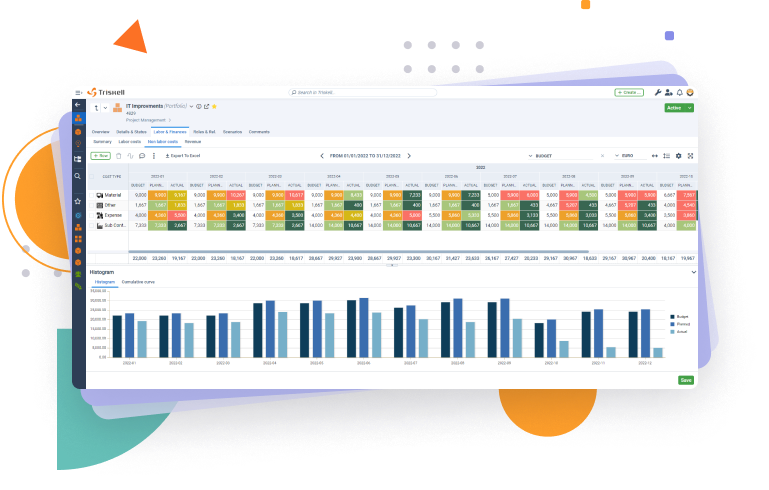
Related Content

7 challenges in new product development and best practices to address them
In this post you will learn some best practices to tackle the major challenges in new product development, from idea validation to quality control.
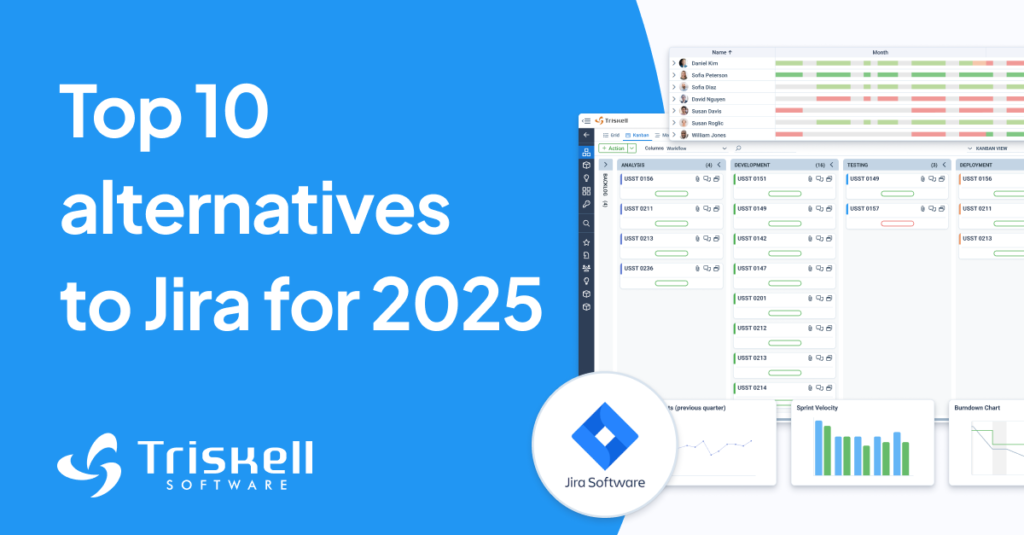
10 best competitors and alternatives to Jira in 2025
Jira is one of the most used tools by medium and large companies. But is it better than Triskell for managing multiple portfolios?

IT Project Management: The ultimate handbook for leading all types of IT projects
Discover best practices for IT Project Management. Learn key frameworks, examples, challenges, and how to optimize IT project success.
FAQ about capacity planning tools
How can capacity planning software help improve long-term strategic planning?
Capacity planning tools allow organizations to align resource allocation with long-term strategic goals.
By offering features like scenario planning, demand forecasting, and advanced analytics, tools such as Planview and Triskell help companies anticipate future needs and ensure that resources are available for upcoming strategic initiatives.
This ensures that businesses are not just reacting to current project demands but are also prepared for future challenges and opportunities.
Can capacity planning tools be used for both Agile and Waterfall project management methods?
Yes, many capacity planning tools support both Agile and Waterfall methodologies. For example, Triskell offers hybrid capabilities, allowing teams to manage Agile sprints while simultaneously supporting more traditional Waterfall projects.
The flexibility to switch between these methods or combine them ensures that your capacity planning aligns with your project execution style, regardless of methodology.
What are the customization options available in capacity planning tools?
Many capacity planning tools offer customizable dashboards, reports, and workflows.
For instance, Triskell allows users to tailor their interface to match specific business needs, adjust resource allocation views, and create custom fields for unique project parameters.
Customization ensures that the tool aligns with your organization’s processes and requirements, making capacity planning more intuitive and effective.

